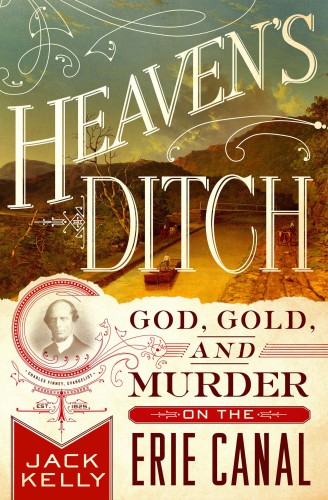
Heaven's Ditch
God, Gold, and Murder on the Erie Canal
کتاب های مرتبط
- اطلاعات
- نقد و بررسی
- دیدگاه کاربران
نقد و بررسی

May 2, 2016
In this snappy telling of an oft-told tale, Kelly (Band of Giants), a journalist, novelist, and historian, brings to life the texture of central and western New York State in the early decades of the 19th century. The region, its settlers, and its culture were central to the nation’s development in the decades before the Civil War. Central and western New York—overrun with religious fervor, political turmoil, and projects to improve life and commerce—incubated much of the cultural change that eventually spread nationally: women’s rights, evangelical religion, abolitionism and other reform movements, and the Erie Canal, one of the great engineering feats of American history. Kelly weaves his story around the construction of the canal, which brought people, trade, and change to the Midwest and helped make New York City into America’s greatest urban center. A writer of history rather than a researcher or interpretive historian, Kelly has mined existing books but not manuscripts or records. He adds nothing to what’s already known about the region’s history, nor does he venture any particular interpretation of his subject. But those who wish to learn something about a critical era and a critical region will find Kelly’s book a good place to start.

May 1, 2016
Historian Kelly (Band of Giants: The American Soldiers Who Won America's Independence, 2014, etc.) weaves together diverse strands of early New York state history for an improbable yet oddly compelling narrative of social, political, and religious visionaries. At the beginning of the 19th century, around the same time that businessman Jesse Hawley was publishing anonymously 14 essays in the Genesee Messenger spelling out his "favorite, fanciful project of an overland canal" across the state of New York, inventor Robert Fulton sailed the first commercial steamboat up the Hudson River, and the future founder of the Mormon sect, Joseph Smith Jr., was born in Vermont to poor tenant farmers who would eventually settle in Palmyra, New York. This period marked the beginning of the Second Great Awakening, sparking outbreaks of religious fervor in unlikely spots. The author explores the lives of itinerant frontier preachers such as Charles Finney, William Miller, and Methodist Lorenzo Dow, among many others, as well as the abduction and probable murder of former Freemason William Morgan, who dared to publish the mysteries of the Freemasons in Batavia, New York, in 1826. Meanwhile, on the hopeful report by New York surveyor James Geddes, Gov. DeWitt Clinton banked his career on spurring financing and construction of the ambitious canal that would link the Hudson and Mohawk rivers at Albany to Lake Erie at Buffalo--360 miles of tangled forests, valleys, and swampland that would open up commerce to an unimaginable degree. Notwithstanding the lack of engineering knowledge, especially about the building of locks, construction got underway by July 4, 1817, requiring horrendous digging by mostly Irish immigrants, and was finally completed in 1825 at the cost of $7 million. As this "psychic highway" flourished and Joseph Smith was embarking on his Book of Mormon, Kelly captures the enormous excitement of these heady days. An intriguing synthesis of American cultural and economic currents in the early 19th century, all culminating with the completion of the Erie Canal.
COPYRIGHT(2016) Kirkus Reviews, ALL RIGHTS RESERVED.

June 1, 2016
Kelly (Band of Giants) provides a comprehensive look at the social, economic, and religious impact resulting from the building of New York state's Erie Canal. With Westward expansion came significant social upheaval and economic dislocation. The birth and spread of the evangelical Christian movement is well documented. The epic clash of commerce, religion, and technology reverberated throughout the 19th century. Upon the completion of the canal in 1825, New York became the financial capital of the country. Joseph Smith, the founder of Mormonism and author of the Book of Mormon, lived for a time in Palmyra, NY, and was murdered in Carthage, IL, while running for president. The disappearance and likely murder of William Morgan, a resident of Batavia, NY, and author of a work about Freemasonry, remains unsolved. Many prominent evangelical preachers are also featured in this detailed narrative. The catastrophes surrounding the canal are no longer visible a century later--summer boaters can now cruise down a quiet (renamed) Barge Canal. An intriguing account of often overlooked events that significantly impacted the lives and times of individuals living during one of the most tumultuous times in American history. VERDICT Recommended for American history buffs in search of stories untold and rarely documented.--Claire Franek, Owensboro, KY
Copyright 2016 Library Journal, LLC Used with permission.

























دیدگاه کاربران